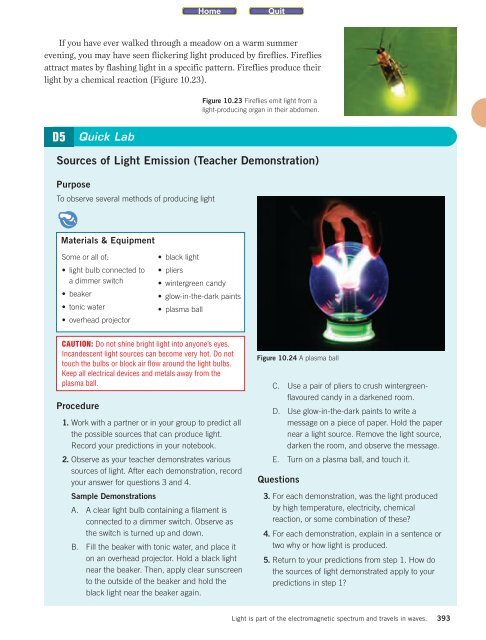is10_sb_unit_d
is10_sb_unit_d
is10_sb_unit_d
Create successful ePaper yourself
Turn your PDF publications into a flip-book with our unique Google optimized e-Paper software.
If you have ever walked through a meadow on a warm summer<br />
evening, you may have seen flickering light produced by fireflies. Fireflies<br />
attract mates by flashing light in a specific pattern. Fireflies produce their<br />
light by a chemical reaction (Figure 10.23).<br />
D5 Quick Lab<br />
Sources of Light Emission (Teacher Demonstration)<br />
Purpose<br />
To observe several methods of producing light<br />
Materials & Equipment<br />
Some or all of:<br />
• light bulb connected to<br />
a dimmer switch<br />
• beaker<br />
• tonic water<br />
• overhead projector<br />
CAUTION: Do not shine bright light into anyone’s eyes.<br />
Incandescent light sources can become very hot. Do not<br />
touch the bulbs or block air flow around the light bulbs.<br />
Keep all electrical devices and metals away from the<br />
plasma ball.<br />
Procedure<br />
• black light<br />
• pliers<br />
• wintergreen candy<br />
• glow-in-the-dark paints<br />
• plasma ball<br />
1. Work with a partner or in your group to predict all<br />
the possible sources that can produce light.<br />
Record your predictions in your notebook.<br />
2. Observe as your teacher demonstrates various<br />
sources of light. After each demonstration, record<br />
your answer for questions 3 and 4.<br />
Sample Demonstrations<br />
A. A clear light bulb containing a filament is<br />
connected to a dimmer switch. Observe as<br />
the switch is turned up and down.<br />
B. Fill the beaker with tonic water, and place it<br />
on an overhead projector. Hold a black light<br />
near the beaker. Then, apply clear sunscreen<br />
to the outside of the beaker and hold the<br />
black light near the beaker again.<br />
Figure 10.23 Fireflies emit light from a<br />
light-producing organ in their abdomen.<br />
Figure 10.24 A plasma ball<br />
C. Use a pair of pliers to crush wintergreenflavoured<br />
candy in a darkened room.<br />
D. Use glow-in-the-dark paints to write a<br />
message on a piece of paper. Hold the paper<br />
near a light source. Remove the light source,<br />
darken the room, and observe the message.<br />
E. Turn on a plasma ball, and touch it.<br />
Questions<br />
3. For each demonstration, was the light produced<br />
by high temperature, electricity, chemical<br />
reaction, or some combination of these?<br />
4. For each demonstration, explain in a sentence or<br />
two why or how light is produced.<br />
5. Return to your predictions from step 1. How do<br />
the sources of light demonstrated apply to your<br />
predictions in step 1?<br />
Light is part of the electromagnetic spectrum and travels in waves.<br />
393


